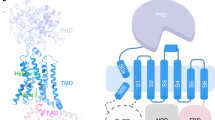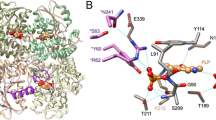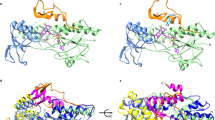Abstract
Protein stability, assembly, localization and regulation often depend on the formation of disulphide crosslinks between cysteine side chains. Enzymes known as sulphydryl oxidases catalyse de novo disulphide formation and initiate intra- and intermolecular dithiol/disulphide relays to deliver the disulphides to substrate proteins1,2. Quiescin sulphydryl oxidase (QSOX) is a unique, multi-domain disulphide catalyst that is localized primarily to the Golgi apparatus and secreted fluids3 and has attracted attention owing to its overproduction in tumours4,5. In addition to its physiological importance, QSOX is a mechanistically intriguing enzyme, encompassing functions typically carried out by a series of proteins in other disulphide-formation pathways. How disulphides are relayed through the multiple redox-active sites of QSOX and whether there is a functional benefit to concatenating these sites on a single polypeptide are open questions. Here we present the first crystal structure of an intact QSOX enzyme, derived from a trypanosome parasite. Notably, sequential sites in the disulphide relay were found more than 40 Å apart in this structure, too far for direct disulphide transfer. To resolve this puzzle, we trapped and crystallized an intermediate in the disulphide hand-off, which showed a 165° domain rotation relative to the original structure, bringing the two active sites within disulphide-bonding distance. The comparable structure of a mammalian QSOX enzyme, also presented here, shows further biochemical features that facilitate disulphide transfer in metazoan orthologues. Finally, we quantified the contribution of concatenation to QSOX activity, providing general lessons for the understanding of multi-domain enzymes and the design of new catalytic relays.
This is a preview of subscription content, access via your institution
Access options
Subscribe to this journal
Receive 51 print issues and online access
$199.00 per year
only $3.90 per issue
Buy this article
- Purchase on Springer Link
- Instant access to full article PDF
Prices may be subject to local taxes which are calculated during checkout



Similar content being viewed by others
Accession codes
Primary accessions
Protein Data Bank
Data deposits
Atomic coordinates and structure factors for the TbQSOX, TbQSOXC and HsQSOX1(PDI) structures have been deposited with the Protein Data Bank under accession codes 3QCP, 3QD9 and 3Q6O, respectively. The MmQSOX1C coordinates and structure factors have been deposited with accession codes 3T58 (orthorhombic) and 3T59 (monoclinic).
References
Riemer, J., Bulleid, N. & Herrmann, J. M. Disulfide formation in the ER and mitochondria: two solutions to a common process. Science 324, 1284–1287 (2009)
Tu, B. P. & Weissman, J. S. Oxidative protein folding in eukaryotes: mechanisms and consequences. J. Cell Biol. 164, 341–346 (2004)
Kodali, V. K. & Thorpe, C. Oxidative protein folding and the quiescin–sulfhydryl oxidase family of flavoproteins. Antioxid. Redox Signal. 13, 1217–1230 (2010)
Antwi, K. et al. Analysis of the plasma peptidome from pancreas cancer patients connects a peptide in plasma to overexpression of the parent protein in tumors. J. Proteome Res. 8, 4722–4731 (2009)
Song, H. et al. Loss of Nkx3. 1 leads to the activation of discrete downstream target genes during prostate tumorigenesis. Oncogene 28, 3307–3319 (2009)
Schulman, S., Wang, B., Li, W. & Rapoport, T. A. Vitamin K epoxide reductase prefers ER membrane-anchored thioredoxin-like redox partners. Proc. Natl Acad. Sci. USA 107, 15027–15032 (2010)
Goodstadt, L. & Ponting, C. P. Vitamin K epoxide redutase: homology, active site and catalytic mechanism. Trends Biochem. Sci. 29, 289–292 (2004)
Zanata, S. M. et al. High levels of active quiescin Q6 sulfhydryl oxidase (QSOX) are selectively present in fetal serum. Redox Rep. 10, 319–323 (2005)
Ostrowski, M. C. & Kistler, W. S. Properties of a flavoprotein sulfhydryl oxidase from rat seminal vesicle secretion. Biochemistry 19, 2639–2645 (1980)
Jaje, J. et al. A flavin-dependent sulfhydryl oxidase in bovine milk. Biochemistry 46, 13031–13040 (2007)
Raje, S. & Thorpe, C. Inter-domain redox communication in flavoenzymes of the quiescin/sulfhydryl oxidase family: role of a thioredoxin domain in disulfide bond formation. Biochemistry 42, 4560–4568 (2003)
Heckler, E. J., Alon, A., Fass, D. & Thorpe, C. Human quiescin-sulfhydryl oxidase, QSOX1: probing internal redox steps by mutagenesis. Biochemistry 47, 4955–4963 (2008)
Kodali, V. K. & Thorpe, C. Quiescin sulfhydryl oxidase from Trypanosoma brucei: catalytic activity and mechanism of a QSOX family member with a single thioredoxin domain. Biochemistry 49, 2075–2085 (2010)
Mitra, P. & Pal, D. New measures for estimating surface complementarity and packing at protein–protein interfaces. FEBS Lett. 584, 1163–1168 (2010)
Inaba, K., Takahashi, Y. H., Ito, K. & Hayashi, S. Critical role of a thiolate-quinone charge transfer complex and its adduct form in de novo disulfide bond generation by DsbB. Proc. Natl Acad. Sci. USA 103, 287–292 (2006)
Fass, D. The Erv family of sulfhydryl oxidases. Biochim. Biophys. Acta 1783, 557–566 (2008)
Alon, A., Heckler, E. J., Thorpe, C. & Fass, D. QSOX contains a pseudo-dimer of functional and degenerate sulfhydryl oxidase domains. FEBS Lett. 584, 1521–1525 (2010)
Appenzeller-Herzog, C. & Ellgaard, L. The human PDI family: versatility packed into a single fold. Biochim. Biophys. Acta 1783, 535–548 (2008)
Levitt, M. Nature of the protein universe. Proc. Natl Acad. Sci. USA 106, 11079–11084 (2009)
Tordai, H., Nagy, A., Farkas, K., Bányai, L. & Patthy, L. Modules, multidomain proteins and organismic complexity. FEBS J. 272, 5064–5078 (2005)
Walter, T. S. et al. Lysine methylation as a routine rescue strategy for protein crystallization. Structure 14, 1617–1622 (2006)
DiMaio, F. et al. Improved molecular replacement by density- and energy-guided protein structure optimization. Nature 473, 540–543 (2011)
Otwinowski, Z. & Minor, W. Processing of X-ray diffraction data collected in oscillation mode. Methods Enzymol. 276, 307–326 (1997)
Leslie, A. G. W. Recent changes to the MOSFLM package for processing film and image plate data. Joint CCP4 + ESF-EAMCB Newslett. Protein Crystallogr. no. 26, (1992)
Evans, P. Scaling and assessment of data quality. Acta Crystallogr. D 62, 72–82 (2006)
McCoy, A. J. et al. Phaser crystallographic software. J. Appl. Cryst. 40, 658–674 (2007)
Eswar, N., Eramian, D., Webb, B., Shen, M. Y. & Sali, A. Protein structure modeling with MODELLER. Methods Mol. Biol. 426, 145–159 (2008)
Brünger, A. T. et al. Crystallography & NMR system: a new software suite for macromolecular structure determination. Acta Crystallogr. D 54, 905–921 (1998)
Afonine, P. V., Grosse-Kunstleve, R. W. & Adams, P. D. The Phenix refinement framework. CCP4 Newslett. no. 42, (2005)
Painter, J. & Merritt, E. A. Optimal description of a protein structure in terms of multiple groups undergoing TLS motion. Acta Crystallogr. D 62, 439–450 (2006)
Emsley, P. & Cowtan, K. Coot: model-building tools for molecular graphics. Acta Crystallogr. D 60, 2126–2132 (2004)
Chen, V. B. et al. MolProbity: all-atom structure validation for macromolecular crystallography. Acta Crystallogr. D 66, 12–21 (2010)
Mitra, P. & Pal, D. New measures for estimating surface complementarity and packing and protein–protein interfaces. FEBS Lett. 584, 1163–1168 (2010)
Xu, H., Zhang, L. & Freitas, M. A. Identification and characterization of disulfide bonds in proteins and peptides from tandem MS data by use of the MassMatrix MS/MS search engine. J. Proteome Res. 7, 138–144 (2008)
Gross, E. et al. Generating disulfides enzymatically: reaction products and electron acceptors of the endoplasmic reticulum thiol oxidase Ero1p. Proc. Natl Acad. Sci. USA 103, 299–304 (2006)
Acknowledgements
S. Rogotner and O. Dym helped in growing the TbQSOXC crystals. We thank T. Ilani and A. Horovitz for reading of the manuscript and N. Nelson and his research group for help with X-ray data collection. A. Moseri assisted with high-performance liquid chromatography. This study was funded by the Israel Science Foundation. D.F. and A.A. acknowledge the Kimmelman Center for Macromolecular Assemblies for additional support. C.T. and V.K.K. acknowledge National Institutes of Health (NIH) grant GM26643. The molecular movie was produced using the University of California San Francisco Chimera package from the Resource for Biocomputing, Visualization and Informatics (supported by NIH grant P41 RR001081).
Author information
Authors and Affiliations
Contributions
A.A. designed experiments, expressed, purified and crystallized proteins, and, together with D.F., solved and refined the TbQSOX, TbQSOXC and MmQSOX1C structures. A.A. also performed the FRET and crosslinking experiments. I.G. improved the TbQSOX crystals. Y.G. grew the MmQSOX1C crystals. V.K.K. and C.T. provided plasmids and helped to design and analyse experiments. F.D. and D.B. accomplished the molecular replacements to solve the HsQSOX1(PDI) structure. T.M. performed the mass spectrometry experiments and analyses. G.H. helped to design and analyse the FRET experiments and assisted with operation of the fluorimeter. D.F. expressed proteins, performed oxygen consumption measurements and designed and analysed the experiments. A.A. and D.F. wrote the manuscript.
Corresponding author
Ethics declarations
Competing interests
The authors declare no competing financial interests.
Supplementary information
Supplementary Information
This file contains Supplementary Figures 1-14, which show experiments that demonstrate the quality of the protein preparations used in this study together with figures that depict in-depth analysis of features of the crystal structures and Supplementary Tables 1-5, which contain statistics and information about crystallography and mass spectrometry analysis. This file also contains a Supplementary Discussion, Supplementary References, and a legend for Supplementary Movie 1. (PDF 11421 kb)
Supplementary Movie 1
This movie depicts one hypothetical trajectory between the two crystallized conformations of Trypanosoma brucei QSOX. The starting conformation is the structure of wild-type TbQSOX; the target conformation is the structure of TbQSOXC, a variant containing a disulfide between the two redox-active domains. (MOV 18617 kb)
Rights and permissions
About this article
Cite this article
Alon, A., Grossman, I., Gat, Y. et al. The dynamic disulphide relay of quiescin sulphydryl oxidase. Nature 488, 414–418 (2012). https://doi.org/10.1038/nature11267
Received:
Accepted:
Published:
Issue Date:
DOI: https://doi.org/10.1038/nature11267
This article is cited by
-
Synthetic innovations for cyclic polymers
Polymer Journal (2022)
-
Allosteric disulphide bonds as reversible mechano-sensitive switches that control protein functions in the vasculature
Biophysical Reviews (2019)
-
Soluble polymorphic bank vole prion proteins induced by co-expression of quiescin sulfhydryl oxidase in E. coli and their aggregation behaviors
Microbial Cell Factories (2017)
-
Erv1 of Arabidopsis thaliana can directly oxidize mitochondrial intermembrane space proteins in the absence of redox-active Mia40
BMC Biology (2017)
-
Identifying specific proteins involved in eggshell membrane formation using gene expression analysis and bioinformatics
BMC Genomics (2015)
Comments
By submitting a comment you agree to abide by our Terms and Community Guidelines. If you find something abusive or that does not comply with our terms or guidelines please flag it as inappropriate.



